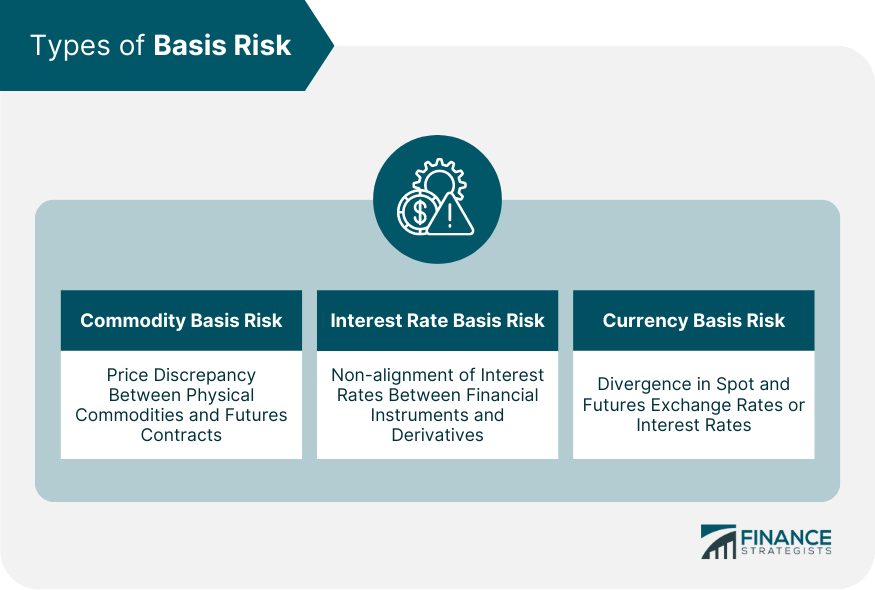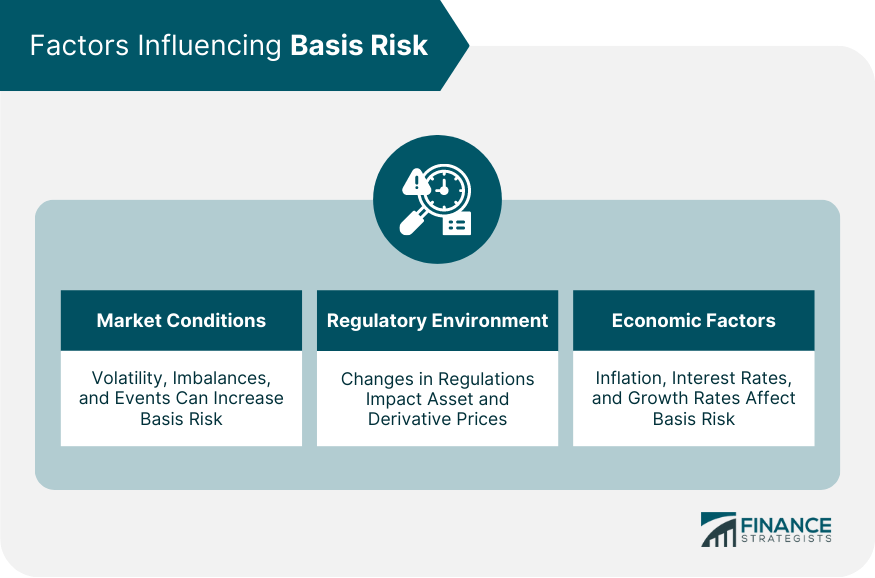Basis risk refers to the financial risk that arises when there is a disparity between the price behavior of a position that is being hedged and the price of the instrument or derivative being used as the hedge. It comes into play when the spot price of the asset and its futures price do not change concurrently. A slight imbalance between these two elements can lead to a significant risk factor. Even a well-planned hedge strategy could fall short if the underlying basis alters in an unforeseen way. This risk is one of the key considerations in derivative trading and risk management. Basis risk forms an inherent part of the derivative markets and is a vital element of the risk management strategies of various financial institutions. The basis can fluctuate due to a number of factors, and any change can lead to significant losses. Basis risk comes into play in the context of futures contracts, derivatives, and hedging strategies. It arises when the price of an asset and the price of a contract or derivative used to hedge that asset do not move in sync. For instance, an oil producer might sell futures contracts to hedge against potential price drops. However, if the price of oil in the futures market does not perfectly mirror the spot market price, the producer faces basis risk. Similarly, a discrepancy can occur in financial markets where a bank hedges its interest rate exposure using futures contracts. If the interest rate on the bank's assets doesn't move perfectly in tandem with the interest rate underlying the futures contract, this discrepancy leads to basis risk. Basis risk occurs when the relationship between the price of a hedged item and the price of the instrument used for hedging deviates from the expected. Commodity basis risk arises when an entity hedges its commodity price risk using futures contracts. The risk occurs when the price of the physical commodity and the futures price do not move in sync. For example, an agricultural firm might use corn futures contracts to hedge against the risk of falling corn prices. However, if the futures price and the spot price diverge, the firm would experience basis risk. Similarly, energy companies often hedge their exposure to oil and gas price fluctuations by using futures contracts. However, basis risk arises if the price movement of these futures contracts does not perfectly match the price movement of the physical commodity. Commodity basis risk, thus, represents the price risk that persists even after hedging attempts. Interest rate basis risk is prevalent among financial institutions that have significant exposure to changes in interest rates. It emerges when the interest rate of a financial instrument does not move perfectly in tandem with the rate of the derivative used as a hedge. For instance, a bank might use an interest rate swap to hedge against changes in the LIBOR. However, if the bank's actual lending rate diverges from the LIBOR, the bank will experience basis risk. Additionally, fluctuations in different maturities or credit qualities of interest rates can also cause basis risk. For example, the rates for Treasury bills and corporate bonds may not always move together, causing basis risk for entities attempting to hedge interest rate risk. Currency basis risk arises in foreign exchange markets and affects companies with substantial international operations. If a U.S. company, for example, anticipates receiving payments in euros and decides to hedge its position against euro depreciation, it might use a euro/USD futures contract. However, if the spot exchange rate and the futures exchange rate move in different directions or degrees, the company will face basis risk. The difference in interest rates between two countries can also contribute to currency basis risk. If a firm hedges its exposure to foreign currency using a swap contract, it would expect the foreign currency's interest rate to move in sync with the domestic currency's rate. If this does not happen, the firm faces basis risk. Volatility in the market can lead to changes in the basis, thus increasing basis risk. Factors such as supply and demand imbalances, geopolitical events, and market sentiment can cause spot and futures prices to diverge. For example, a sudden increase in the demand for a commodity could cause its spot price to rise more rapidly than the futures price, leading to an increase in basis risk. Market conditions are dynamic and unpredictable, making it essential for investors and institutions to monitor them regularly. Changes in financial regulations can affect the prices of both the underlying asset and the derivative used for hedging, leading to potential discrepancies between the two. For instance, changes in laws related to commodity production or trading can affect the spot prices of those commodities. If these changes do not affect the futures prices in the same way, it could lead to an increase in basis risk. Therefore, staying abreast of the regulatory environment is crucial in managing basis risk. Inflation, interest rates, and economic growth rates can all play a part in determining the spot and futures prices of assets. Inflation can cause the prices of commodities to rise, which may not be immediately reflected in the futures prices, leading to a change in the basis. Similarly, changes in interest rates can affect the prices of financial assets and their corresponding futures contracts differently. Economic factors are integral to the pricing of assets and derivatives, thus playing a significant role in basis risk. By measuring the potential discrepancies between the spot and futures prices of an asset, investors and financial institutions can better understand the extent of the risk they face. This can be achieved through various methods, including statistical analysis and scenario modeling. These techniques can provide valuable insights into the potential changes in the basis and help entities to prepare for different market scenarios. By selecting the right hedging instrument and carefully determining the hedge ratio, entities can minimize the potential discrepancies between the spot and futures prices. For example, instead of using a standard futures contract, a company might choose a more specialized derivative that better matches the characteristics of the asset being hedged. Also, the company can adjust the number of futures contracts used in the hedge to better align with the expected price behavior of the asset. By fine-tuning their hedging strategies, entities can significantly reduce their exposure to basis risk. These techniques involve the strategic allocation of assets in a portfolio to minimize risk and maximize returns. They can help to balance out the effects of basis risk by ensuring that the portfolio is well-diversified and includes assets that are less likely to be affected by changes in the basis. For instance, an investor might include assets in their portfolio that are expected to benefit from changes in the basis that could negatively impact other assets. This way, the losses from one asset can potentially be offset by the gains from another, reducing the overall impact of basis risk on the portfolio. Basis risk refers to the potential loss that arises when there is a mismatch or imperfect correlation between two related financial instruments or indexes. It occurs due to variations in pricing or valuation between these instruments, leading to financial uncertainty and potential losses. It occurs when the prices or values of related instruments or indexes diverge. Market conditions, including volatility and liquidity, play a significant role in determining the degree of basis risk. The regulatory environment and government policies can impact the pricing and availability of financial instruments, affecting basis risk. Additionally, economic factors such as inflation rates and economic indicators can influence the relationship between different instruments or indexes, further impacting basis risk. By quantifying basis risk, employing appropriate hedging strategies, and considering relevant factors, individuals and organizations can mitigate potential losses and make informed financial decisions.What Is Basis Risk?
How Basis Risk Works
Types of Basis Risk
Commodity Basis Risk
Interest Rate Basis Risk
Currency Basis Risk

Factors Influencing Basis Risk
Market Conditions
Regulatory Environment
Economic Factors

Mitigation of Basis Risk
Quantifying Basis Risk
Hedging Strategies
Portfolio Optimization Techniques
Conclusion
Basis Risk FAQs
Basis risk refers to the potential loss that arises when there is an imperfect correlation between two related financial instruments or indexes. It occurs when the prices or values of these instruments or indexes diverge from each other, resulting in financial uncertainty and potential financial losses.
Basis risk can manifest in different forms. Commodity basis risk occurs when there is a mismatch between the price of a commodity in the spot market and the price of its corresponding futures contract. Interest rate basis risk arises from differences between the interest rates used for pricing financial instruments, such as floating-rate loans and fixed-rate hedges. Currency basis risk occurs when there are disparities between the exchange rates used for currency conversions.
Several factors can influence basis risk. Market conditions, including volatility and liquidity, play a significant role. Changes in regulations and government policies can impact the pricing and availability of financial instruments, contributing to basis risk. Economic factors, such as inflation rates and economic indicators, can also affect the relationship between different financial instruments or indexes.
Basis risk can be mitigated through various strategies. Quantifying basis risk involves measuring and assessing the extent of the potential divergence between related instruments or indexes. Hedging strategies, such as using derivatives or employing offsetting positions, can help minimize the impact of basis risk. Additionally, portfolio optimization techniques, such as diversification, can reduce exposure to specific basis risks by spreading investments across different assets or markets.
Basis risk is essential in finance as it affects decision-making, risk exposure, and overall portfolio performance. Failing to account for basis risk can lead to unexpected losses or missed opportunities. Understanding and effectively managing basis risk is crucial for financial institutions, investors, and corporations to make informed decisions, mitigate potential losses, and enhance portfolio returns.
True Tamplin is a published author, public speaker, CEO of UpDigital, and founder of Finance Strategists.
True is a Certified Educator in Personal Finance (CEPF®), author of The Handy Financial Ratios Guide, a member of the Society for Advancing Business Editing and Writing, contributes to his financial education site, Finance Strategists, and has spoken to various financial communities such as the CFA Institute, as well as university students like his Alma mater, Biola University, where he received a bachelor of science in business and data analytics.
To learn more about True, visit his personal website or view his author profiles on Amazon, Nasdaq and Forbes.











